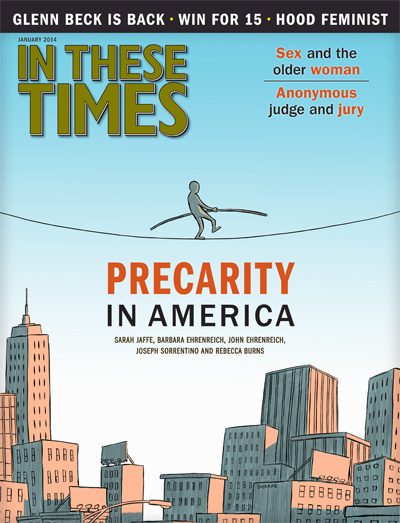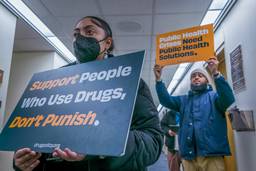An Anonymous Judge and Jury
For digital vigilantes, accused rapists are guilty until proven innocent.
Jude Ellison Sady Doyle

In January 2012 in Maryville, Mo., Melinda Coleman found her daughter Daisy, 14, on the front doorstep. Daisy was dressed in a T-shirt and sweatpants, in 22-degree weather. She reported being raped. She said that she’d been with 17-year-old Matt Barnett, who had given her a glass of something she couldn’t identify, and had lost consciousness. The doctor who examined Daisy said there was “no doubt” a crime had occurred. Barnett admits to “having sex” with Coleman and recording it on his iPhone. Another girl, 13-year-old Paige Parkhurst, reported being raped at the same party that night by a 15-year-old boy. According to the sheriff, within four hours he had the suspects in custody and had received confessions. But the charges were dropped. And, after reporting the rape, Coleman says that she and her family were bullied so severely that she feared leaving the house and attempted suicide, twice.
Then digital-vigilante collective Anonymous got involved. As they had in the more famous Steubenville, Ohio, gang-rape case, they set out to expose both the alleged rapists and the complicity of the townsfolk. They also pushed for Coleman’s case to be reopened; and in October, a Missouri judge appointed a special prosecutor to do so. But in the Steubenville case, the actions of Anonymous resulted in widespread, pernicious misinformation. Harassment and death threats were aimed at many innocent people.
In These Times asked three experts to discuss how digital vigilantism works and what might prevent it from being a useful tool in fighting rape culture: Jill Filipovic, an attorney, Guardian columnist and Feministe blogger who has reported on the dangers of digital vigilantism; Cole Stryker, author of Hacking the Future: Privacy, Anonymity and Identity on the Internet; and Soraya Chemaly, a columnist for the Huffington Post who covered the Steubenville case.
Help keep this reporting possible by making a donation today.
Anonymous put out a lot of misinformation in Steubenville, including allegations of a “child porn ring.” What’s the cost of misinformation in cases like these?Jill: Misinformation is pretty much the rule in these digital vengeance initiatives — which is part of the reason why we have a justice system with multiple layers of checks. I think we’d be better served by interrogating how cultural biases influence things like evidentiary rulings and perceptions of what’s a winnable case, rather than having anonymous online activists jump in with an ethos of spreading any information, with no safeguards or consequences when they get things terribly wrong.
Soraya: I think that if people are worried about misinformation, their first line of defense would be to push their communities to seek the truth. When I consider the possible harm that this kind of vigilantism can result in, I think of it as a phase of transition and an incentive for people to redefine the norms that lead to institutional incompetence.
There are real-world deterrents to reporting rape. It’s hard to get a case brought to court, hard to prove and often results in inadequate sentencing.
Jill: Our justice system is created by human beings — it’s not some otherworldly, totally fair thing existing outside of the realm of our culture and our biases. But the digital world isn’t necessarily better. The threat of digital ven- geance may make prosecutors more ag- gressive when investigating rape cases, but that doesn’t address the root problem of pervasive cultural sexism.
Jill wrote in her piece on Maryville that there’s a difference between activism and vigilantism. Where is that line?
Cole: I support individuals blowing the whistle on corporate corruption, but I tend to sympathize with people, even universally despised cretins. Vigilante mobs don’t tend to concern themselves with proportionality in their retribution. At least the criminal justice system pretends to concern itself with punishments that fit the crime.
Jill: You’re right that it’s basically impossible to draw a bright line. It comes down to what you do, and what you’re asking people to do. If you’re writing about the case in a publication or on your blog or on Facebook to raise awareness, or if you email a local official to raise concerns about unethical actions on the part of a DA, or if you give a rape victim a platform on which to tell her story, that’s activism. And the feminist blogosphere has been particularly effective at challenging standard definitions of rape and countering slut-shaming narratives. But at the point where you try to achieve “justice” yourself by, say, anonymously harassing men who have been accused of rape or people in a town you believe are enabling those men, that crosses a line.
Cole: Anonymous vigilantism is by nature unwieldy. If I blow the whistle on a rape, which kickstarts a nationwide shaming campaign, and then someone shows up at the guy’s house and shoots him, is the original whistle-blower supposed to feel bad? I wouldn’t think so. But these campaigns often do spiral out of control.
Jill: There’s also the question of how sure we are about the role that other people played. With a crime like sexual assault, the victim is usually telling the truth, but in cases like Steubenville and Maryville, the blame wasn’t just laid at the feet of the rapists. It was directed at law enforcement, prosecutors, townspeople, etc. The anger isn’t unwarranted, but the conclusions about what happened and the roles all of those people played (and the attendant harassment) were. There was a lot of bad information swirling around, and a lot of it got out of control.
Even if we can expose and shame rapists and those who cover for them, does that help?
Cole: Having grown up among unapologetic racists, I argue that shaming generates the opposite of its stated intent. People who hold unfortunate ideas about race and sex tend to cluster in groups of perpetual ideological reinforcement. When shamed, they re- treat into such enclaves and convince each other that they’re the ones doing the right thing. If anything, shaming can hope to mitigate public manifestations of these toxic memes, but it also strengthens them internally. I’ve never met an asshole who changed his heart or mind via embarrassment.
But perhaps shamers are just looking to let people with bad ideas know that they’ll experience painful consequences.
Cole: I don’t have room for that argument in my personal moral framework. One of the most profound moments of civilization’s social evolution is the idea that punishment should be doled out with an eye toward rehabilitation. Which is why we don’t, say, flog our prisoners anymore.
Soraya: I’m not big on shaming individuals either, but I am stuck on this idea that people’s incentives to think differently, to look at ugliness and confront harsh realities are basic, and avoiding shame is one of the most fundamental.
Coleman says she’s glad for #justice4daisy, and credits it with the fact that her case has been reopened by a special prosecutor. Would that have been possible without Anonymous?
Soraya: No, I don’t think so. I have exchanged many emails with the parents of [bullying victim] Amanda Todd and [rape victim] Raehtah Parsons. I doubt that they would have been able to accomplish much without similar actions. Glenn Canning, Parsons’ father, wrote a letter of thanks to Anonymous.
Jill: But do we want victims being the ones making the determinations in criminal cases? If a victim of a rape would be happy to see her attacker raped in prison or otherwise brutalized — a position that I can certainly understand on an emotional level — should that translate into policy or in any way influence efforts to make prisons more humane places?
Although we can debate tactics, or effectiveness, we seemingly can’t put the cat back in the bag when it comes to digital vigilantism. The technology is out there, and people are going to use it.
Cole: I feel, as writers, the best good we can do is convince fellow media to (a) not report every baseless claim, (b) recognize the power you wield to ruin someone’s life, and © be quick to condemn behaviors, but give people more benefit of the doubt than you think they might deserve. It’s worth recognizing your own fallibility before piling onto people.
Soraya: I also try to spend a whole lot of time talking about the way these stories are framed in media and trying to engage people to think critically in general about the information we consume. I don’t think this situation will change until we start allowing boys to cross-gender empathize and do justice-in-the-classroom stuff super early.
That’s really long-term.
Jude Ellison Sady Doyle is an In These Times contributing writer. They are the author of Trainwreck: The Women We Love to Hate, Mock, and Fear… and Why (Melville House, 2016) and was the founder of the blog Tiger Beatdown. You can follow them on Twitter at @sadydoyle.









